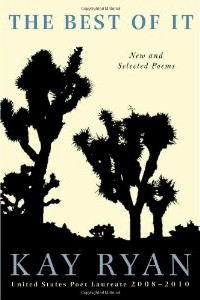
Kay Ryan's Stanford reading (2010) from The Best Of It: New and Selected Poems.
Kay Ryan's Time Line.
Books by Kay Ryan:
 The Best of It: New and Selected Poems (2010).
The Best of It: New and Selected Poems (2010).
 The Jam Jar Lifeboat and Other Novelties Exposed (2008).
The Jam Jar Lifeboat and Other Novelties Exposed (2008).
 The Niagara River (2005).
The Niagara River (2005).
 Say Uncle (2000).
Say Uncle (2000).
 Elephant Rocks (1996).
Elephant Rocks (1996).
 Flamingo Watching (1994).
Flamingo Watching (1994).
 Strangely Marked Metal (1985).
Strangely Marked Metal (1985).
 Dragon Acts to Dragon Ends (1983).
Dragon Acts to Dragon Ends (1983).
|
The Best Of It: New and Selected Poems (2010)
Kay Ryan's Stanford reading (2010) from The Best Of It: New and Selected Poems. |

|
|
The Niagara River (2005)
One of her two best books as of its publication. |

|
|
Say Uncle (2000)
Her best book, as of its publication in 2000. |

|
|
Elephant Rocks (1996)
This is the transitional book,
|

|
Take out your copy of Kay Ryan's Say Uncle (2000) and read the title poem (p. 1), which starts and ends thus:
Every day you say, just one more try. ... why won't you say uncle. |
Notice and admire the contents: how "Say Uncle" teeter-totters between on the one hand being an acceptance and a giving up while on the other hand being a celebration of hanging on even in the face of great difficulty. While this poem applies to any difficult decision or relationship, it's also a poem about the difficulty of being a poet or artist.
Notice and admire the form: the brevity (small number of very short lines), the inner rhymes and slant rhymes, the wit, the surprises.
Take out your copy of Kay Ryan's The Niagara River (2005) and read her poem "Houdini" (p. 46):
Each escape involved some art, some hokum, ... It was the hardest part to get right routinely: breaking back into the same Houdini. |
These two poems exemplify what I admire about Kay Ryan's mature poetic style:
Again take out your copy of Kay Ryan's Say Uncle (2000) and read her poem "Why We Must Struggle" (p. 54):
If we have not struggled as hard as we can at our strongest how will we sense the shape of our losses or know what sustains us longest ... how loss activates a latent double, how we can feed as upon nectar upon need? |
Joseph Parisi (in 100 essential modern poems by women (2008)) writes:
| Kay Ryan's witty poems are bracing distillations of her precise observations of the world and the vagaries of humankind. Aside from the shardlike fragments of Sappho or the sharpest of haiku, it is unusual to find such compression of thought and deftness of touch as are typical of her minimalist art ... fine craftsmanship and subtly subversive tendencies. |
Dennis Morton, host of the KUSP public radio Poetry Show, in an email exchange (2010) praising KR's work:
| It takes genius to pare the redundancies from one's writing, to have that sense of the essential and to resist embellishment. I think it also takes a bit of bravery, as a poet, to say "that's it: it's all there, in that small bundle". |
Dana Goia, whose essay reprinted at http://www.danagioia.net/essays/eryan.htm was one of the first to praise her work, writes:
| Kay Ryan's magnificently compressed poems shimmer exuberantly not only with joy and intelligence but also with genuine wisdom. |
Finally look again at your copy of Kay Ryan's The Niagara River (2005) and read her poem "Tar Babies" (p. 25):
Tar babies are not the children of tar people. It is far worse. The tar baby occurs spontaneously ... When you start to help her is when she starts to stick. |
Kay Ryan's poems are likely to last for centuries - at least I hope so. In addition to their worthiness of content and form as noted above, these issues relate to their survival likelihood:
|
The Niagara River (2005)
One of her two best books as of its publication. |

|
|
Say Uncle (2000)
Her best book, as of its publication in 2000. |

|
|
Elephant Rocks (1996)
This is the transitional book,
|

|
In her 15 February 2006 City Arts and Lectures event, Kay Ryan said whose work she prefers to read, which is consistent with my finding a stong resonance of Ryan's work with Larkin's:
| I read the noble dead: Donne, Hopkins, Larkin, Housman. |
Related pages:
 Books of Poetry Form. Books of Poetry Form.
 Alphabetic list of poetry forms and related topics.
Alphabetic list of poetry forms and related topics.
 How to Write Poetry. How to Write Poetry.
|
|
Copyright © 2010-2016 by J. Zimmerman, except for the quoted poems.
All poems Copyright © 1985-2015 by Kay Ryan. All rights reserved. |
[Thanks for visiting.]